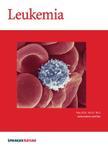版权所有:内蒙古大学图书馆 技术提供:维普资讯• 智图
内蒙古自治区呼和浩特市赛罕区大学西街235号 邮编: 010021

作者机构:Radboud Univ Nijmegen Med Ctr Cent Hematol Lab NL-6500 HB Nijmegen Netherlands Radboud Univ Nijmegen Med Ctr Dept Hematol NL-6500 HB Nijmegen Netherlands Erasmus Med Ctr Rotterdam Inst Hematol Rotterdam Netherlands
出 版 物:《LEUKEMIA》 (白血病)
年 卷 期:2005年第19卷第5期
页 面:799-805页
核心收录:
学科分类:1002[医学-临床医学] 1001[医学-基础医学(可授医学、理学学位)] 10[医学]
主 题:PML-RAR alpha acute promyelocytic leukemia ID proteins basic helix-loop-helix transcription factors
摘 要:Acute promyelocytic leukemia (APL) is uniquely sensitive to treatment with all-trans retinoic acid ( ATRA), which results in the expression of genes that induce the terminal granulocytic differentiation of the leukemic blasts. Here we report the identification of two ATRA responsive genes in APL cells, ID1 and ID2. These proteins act as antagonists of basic helix - loop helix ( bHLH) transcription factors. ATRA induced a rapid increase in ID1 and ID2, both in the APL cell line NB4 as well as in primary patient cells. In addition, a strong downregulation of E2A was observed. E2A acts as a general heterodimerization partner for many bHLH proteins that are involved in differentiation control in various tissues. The simultaneous upregulation of ID1 and ID2, and the downregulation of E2A suggest a role for bHLH proteins in the induction of differentiation of APL cells following ATRA treatment. To test the relevance of this upregulation, ID1 and ID2 were overexpressed in NB4 cells. Overexpression inhibited proliferation and induced a G0/G1 accumulation. These results indicate that ID1 and ID2 are important retinoic acid responsive genes in APL, and suggest that the inhibition of specific bHLH transcription factor complexes may play a role in the therapeutic effect of ATRA in APL.